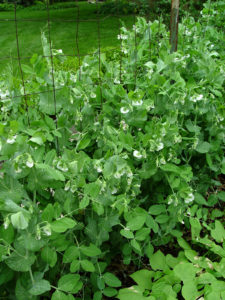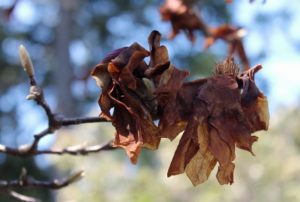Weird Weather and the Other Meaning of St. Paddy’s Day
March 14th, 2017
To most people, this Friday’s St. Patrick’s Day is a time to celebrate Irish heritage, usually with shamrocks, green clothing and green beer.
But to gardeners, the occasion means green of another sort – time to plant the peas.
That’s not going to happen this year since the prevailing color is now white. When gardens aren’t buried under a foot or so of snow, lots of vegetable gardeners use the March 17 St. Paddy’s milestone as the semi-official start of the gardening season. They know peas are about as cold-hardy as any edible, capable of sprouting around here even in the sometimes-frozen soil of late winter.
This year, though, who knows what’s going to happen? We’ve already had April in February, when buds and shoots progressed to the point of opening way too soon by the time winter returned with a snowy vengeance.
Having magnolias in bloom and leaves sprouting on the hydrangeas the first week of March might be good therapy for winter-haters, but it’s risky behavior for plants. Those nights down into the teens last weekend look like they spelled doom for at least some buds and plant crowns. Too bad the insulation from the snow didn’t happen before the cold nights punished the bare leaves, buds and crowns.
Most of our winter-hardy plants are pretty good about protecting themselves in winter.
Perennials die back to the ground, bulbs keep their flower-producing shoots underground until the time is right, and tree and shrub buds stay tight and dormant until longer days and warmer temperatures trigger growth.
Most plants are “smart” enough not to start growing when we get a warm spell for a few days here and there in winter.
But what happened this year is that we got sustained warmth that went on for weeks – much of the time into the 60s and 70s and even close 80 in late February.
That was enough to trick plants into developing to where they’d normally be in late March. Even the grass turned green and started inching up as February handed off to March.
This isn’t necessarily a problem… unless very cold weather returns to zap premature growth. I’m afraid that’s exactly what happened last weekend when a few more days into the upper 50s were followed by sub-20-degree nights. We’ll know for sure how much damage occurred when we get to the “real” spring.
If damage isn’t as bad as my pessimism dictates, plants will pause in this week’s snow, then continue onward after it melts. Assuming the premature plants haven’t turned to mush in this weather confusion, they’ll probably leaf out sooner, bloom sooner, and maybe even bloom longer if temperatures cool once the flowers open.
Sudden nosedives can be enough to turn opened magnolia flowers into mush, curl and kill young shrub leaves, and singe the tips of flower buds showing color. The crowns of perennials (the point where growth emerges) can suffer dieback if they’ve started sending up leaves that can’t tolerate sub-20 nights. At worst, cold kills the prematurely activated crowns and the plants along with them.
The stage of growth when cold weather happens makes a big difference. The same flower bud or crown that suffers no damage on a single-digit night when dormant could die completely if the low dips into the mid-20s when it’s just opened.
That’s exactly what happened last year to many fruit trees and bigleaf hydrangeas. We had enough warm days that their flower buds had opened by the third week of April, when a sudden cold snap came along that took nighttime lows down to 23 or 24 degrees for two nights.
The result was fewer (or no) fruits on the peach and apricot trees, and a poor year for hydrangea flowering in June.
Even at this week’s St. Paddy’s Day, we still have plenty of time for even more winter weather to happen.
Other than draping sheets or floating row covers over plants or erecting burlap barriers, there’s not much you can do when nights get really cold. You’d need a 30-foot blanket to protect that blooming magnolia.
Even blanketing only buys you a few degrees of protection. If it gets cold enough fast enough, damage is going to happen no matter what you do.
That’s why I generally take the lazy-man option in situations like this and let nature do what it’s going to do… then pick up the pieces later.
Often, cold damage often kills only the current year’s flower buds or early set of leaves but doesn’t harm the plant itself. Trees and shrubs go on to grow a new set of leaves to replace the frost-killed premature ones, and perennials will push up fresh shoots to replace the browned-out ones.
If branch tips or whole branches die, trim off the dead wood. Unless you lose a lot, patience will yield a plant that won’t look worse for the wear in a year or two – and maybe even by mid-season this year. (Just wait until at least June to cut; you want to be sure the wood is dead, not just still in the process of generating new growth.)
For bulbs, most of them will be fine… although I did see some of my daffodil stems drooping over before the snow That’s not a good sign and one I’ve never had happen in more than 35 years of gardening.
Don’t worry at all about the grass. It’ll slow down or even stop growing if it turns cold, then get busy again when it warms again.
If it helps any, keep in mind that plants are generally more resilient than we them credit for. Erratic weather isn’t a good thing, but I’d be surprised if many plants actually die, even with another cold snap or two until we get to the frost-free safety of May.
Let’s hope those aren’t regretful last words…









